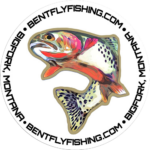MONTANA WATER FLOWS: RIVERS & STREAMS
FREESTONE RIVERS
The most common type of river and what we fish most often are called freestone rivers. This means that it flows seasonally and is dependent on winter snowpack and rain. Freestone rivers can vary in size from small mountain creeks to large flowing rivers, to classify as a freestone it must be entirely rain and snow melt and have no dams.
While freestone rivers are fabulous for fishing, during the spring months, conditions can change quickly. When the snow in the mountains starts to melt and is met with heavy rain, the flows can blow up fast. It is important to know the conditions of the water before going out to keep you and the others in your boat safe. The United States Geographical Survey keeps an accurate recording of Montana water flows for many of the rivers we fish. This is an excellent resource to have on hand especially during spring when conditions are rapidly changing.
TAILWATER AND DAMS
Bent Fly Fishing guides pay attention to Montana water flows and stay informed on current conditions. Knowing the different types of water and flows is an important part of our lifestyle. For flowing water, there are three main types that you can fish on. One of those kinds is called tailwater, the Missouri River is a famous example. This means that there is a dam on the waterway, but it is usually referring to the river right below the dam. Since the dam has major control over the water flows and the temperature, it creates a consistent environment where the trout thrive. When the river is let through the dam, it is usually released from the bottom where the coldest water sits in the reservoir on the other side. The influx of cold water helps to keep river temperatures cooler even in the hot months of summer.





